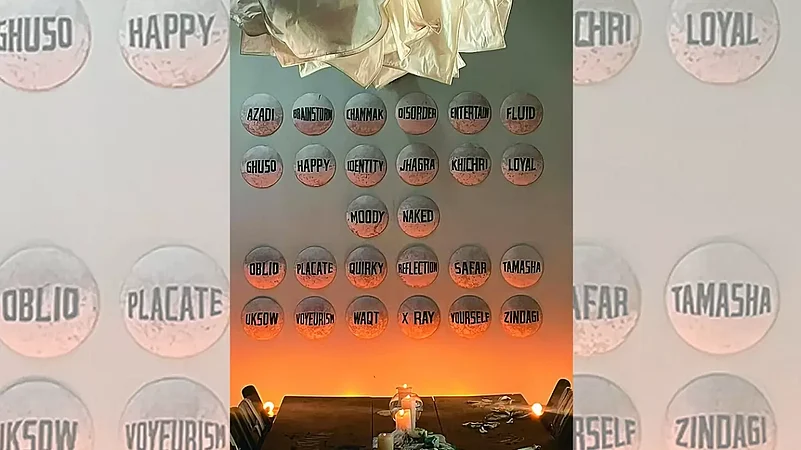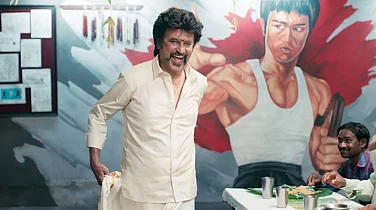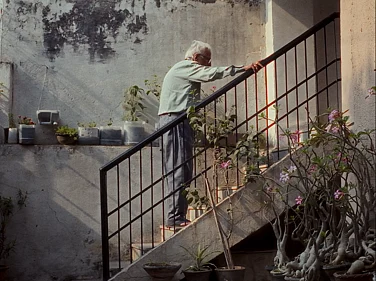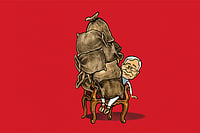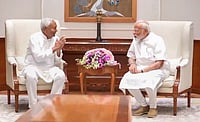“For an artist, there’s nothing better than having the opportunity to create a world that doesn’t—but could—exist.”
—Christophe Lautrette
In this house, where doors have transformed into tables on which candles have melted and formed rivers of memories of conversations, where dead flowers find a home in scrapbooks and where a boat has learned to stay still on concrete, there is a wall with convex metal plates, a storyboard almost of feelings. The letters bend outward to form imaginary worlds. Like her.
Aradhana Seth enters a world that’s made up of words and she constructs rooms, conjures storms, build landscapes out of stories. That also means she passes time in a matrix of several perceived realities simultaneously. The real finds its footing in the reel. That’s another kind of language. Of things. Of spaces.
She, the creator of worlds that characters inhabit, knows the ephemerality of everything. A wall in her Goa house, where she lives, bears testimony to that. Everything is fluid in her space. That’s a good place to begin to understand a production designer who isn’t only that. There is a methodology to the wall. It begins with A and ends with Z. Azadi and zindagi. In between, the other letters project other emotions. The bulge of the metal plates hide inside them invisible states of minds, the various galaxies, stories that are always eternal.
“The omnipresence of all worlds that are present in us,” she says. It is a brave act then to render one’s own space as a place of obituaries of worlds once formed, then demolished. Some forgotten. Some remembered. Some works in progress. A memory museum. Moving on is an essentiality. From one room to another, from one film to another. Like a time machine.
The house and the objects from various sets she has created and the wall are all celebrations of the imagination, of the co-existence of the inner and the outer, the real and the unreal. The imagination creates a relationship with a story and takes it to a place no one knows it could go, creating a depth of experience, expanding from three dimensions to a multiplicity of dimensions.
On another wall, there is a shrine. An ever-evolving altar, with no ambition, no allegiance, no borders. This wall doesn’t divide. You could call it a wall of unity. Three altars – one from the house that was once owned by a priest, one from the sets of Bourne Supremacy and the third from Darjeeling Limited where she created a fantastical train. There are other deities from other films, friends and places. There is also the Indian Constitution.
It was during the demolition of the four houses that were built for Bourne Supremacy that she felt that her heart was breaking.
A conjurer of storms within and without, of merging the real with surreal like the getaway plane in Don, compressing and collapsing time by ageing a house in East is East, by using a sequinned embroidered frame to show longing in domesticity, she traverses many spaces and eras.
In a house with huge pillars in Patna where she spent a part of her childhood, she played hide and seek which made her understand layouts. She would go to other peoples’ homes and rearrange their furniture in her head. That’s how it began. All this mapping, rearranging and building and locating and translating the writers’ and directors’ words into a crystallized universe that complements the storytelling, becomes its setting and even sometimes become the dialogue with symbolism.
“I try and feel the characters, understand where they are within that time and space,” she says.
The director-designer relationship perhaps is the most intense and lasts longer than others. Production designers present a world known and imagined and shape how we see and yet, never leaving a footprint in that universe they create, learning to be invisible. That’s a tough one. Even tougher is to leave worlds, homes, rooms and move on to other universes. But something remain. Like the frame, the altar, the memories.
(This appeared in the print edition as "Elsewhere Worlds")
Chinki Sinha, from Aradhana Seth’s house in Goa







